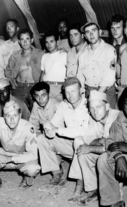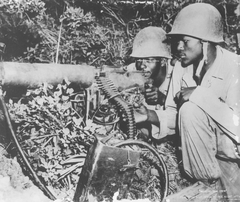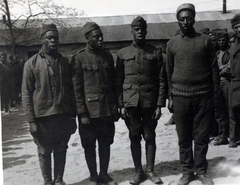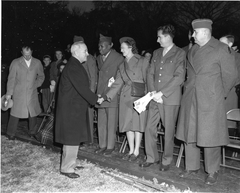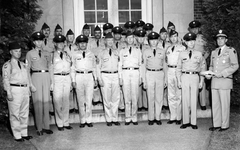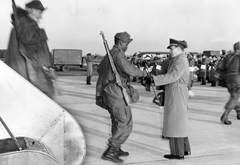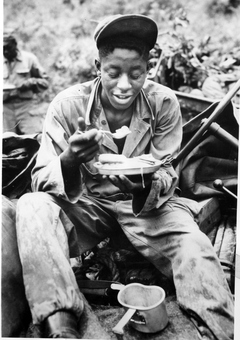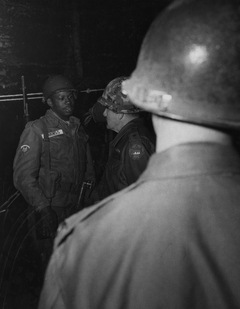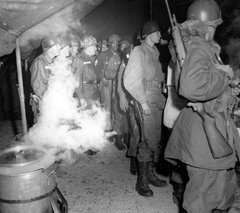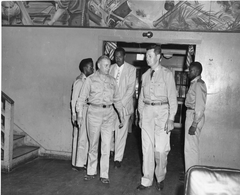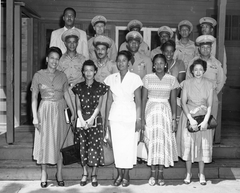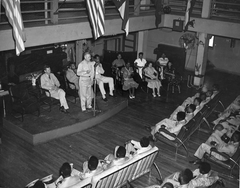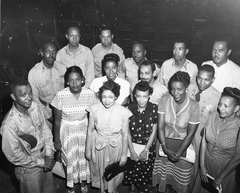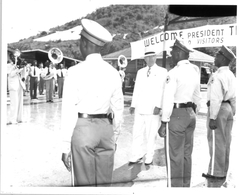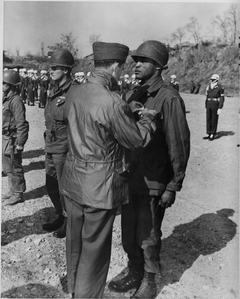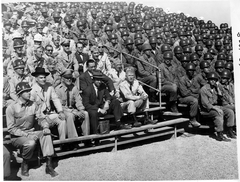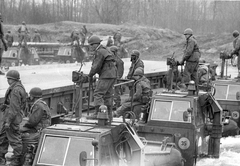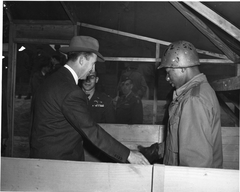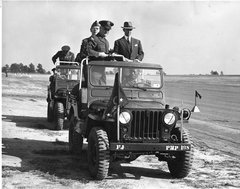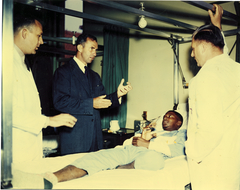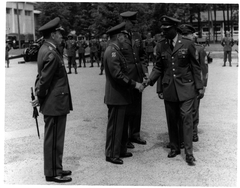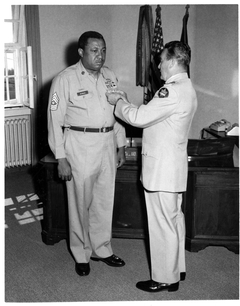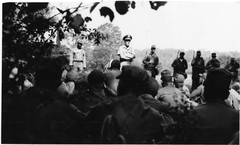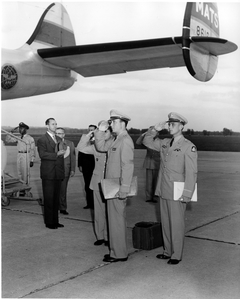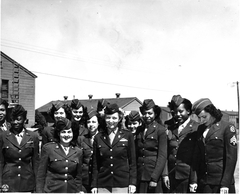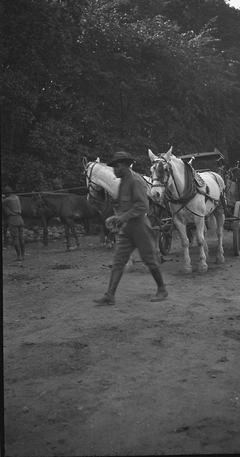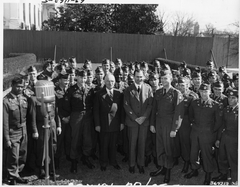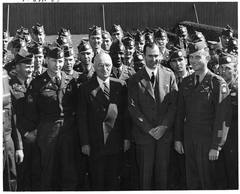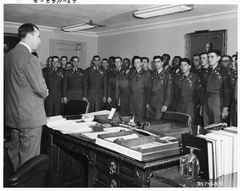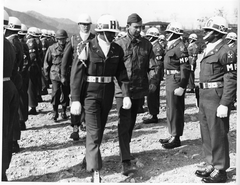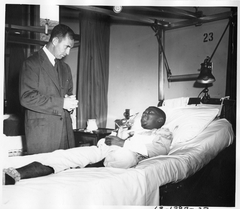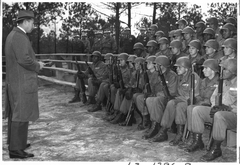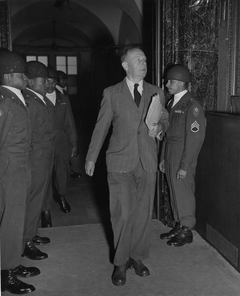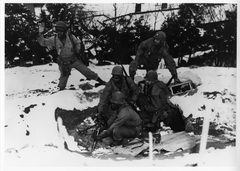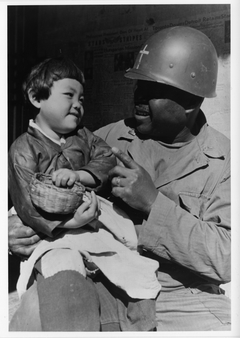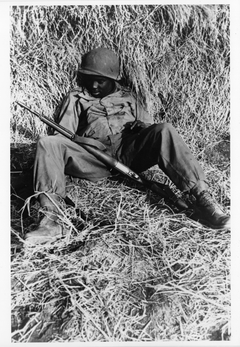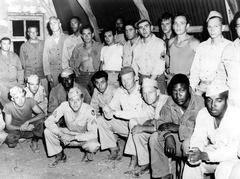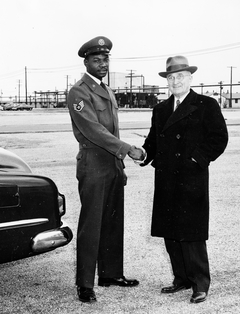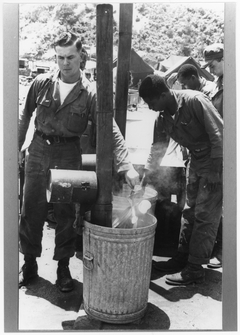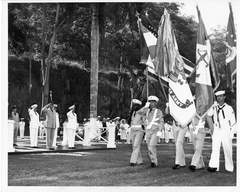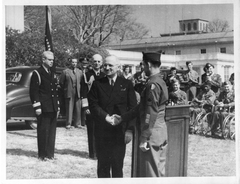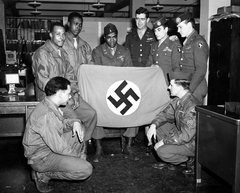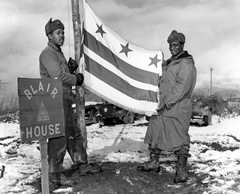This collection focuses on President Truman's decision to desegregate the U.S. Armed Forces. The collection includes 247 documents totaling 1188 pages covering the years 1938 through 1953. Supporting materials include photographs, oral history transcripts, a subject guide to archival materials and a Truman Library finding aid which contains Freedom to Serve, the final report of the Fahy Committee.
Desegregation of the Armed Forces
Documents
Displaying 1 - 228 of 228 documents
1938
1940
1941
1942
1943
1944
1945
1946
1947
1948
1949
1950
1951
1952
1953
Background
1945
- September: Secretary of War Robert P. Patterson appoints a board of three general officers to investigate the Army's policy with respect to African-Americans and to prepare a new policy that would provide for the efficient use of African-Americans in the Army. This board is called the Gillem Board, after its chairman, General Alvan C. Gillem, Jr.
- October 1: The Gillem Board holds its first meeting. Four months of investigation follow.
1946
- February: African-American World War II veteran Isaac Woodard is attacked and blinded by policemen in Aiken, South Carolina.
- April: The report of the Gillem Board, "Utilization of Negro Manpower in the Postwar Army Policy," is issued. The report concludes that the Army's future policy should be to "eliminate, at the earliest practicable moment, any special consideration based on race." The report, however, does not question that segregation would continue to underlie the Army's policy toward African-Americans. Secretary of the Army Kenneth Royall later characterized the policy recommended by the Gillem Board as "equality of opportunity on the basis of segregation."
- July: Two African-American veterans and their wives are taken from their car near Monroe, Georgia, by a white mob and shot to death; their bodies are found to contain 60 bullets.
- July 30: Attorney General Tom Clark announces that President Truman has instructed the Justice Department to "proceed with all its resources to investigate [the Monroe, Georgia atrocity] and other crimes of oppression so as to ascertain if any Federal statute can be applied."
- September 12: In a letter to the National Urban League, President Truman says that the government has "an obligation to see that the civil rights of every citizen are fully and equally protected."
- December 6: President Truman appoints the President's Committee on Civil Rights.
1947
- May: The President's Advisory Commission on Universal Training gives a report to the President in which it concludes that "nothing could be more tragic for the future attitude of our people, and for the unity of our Nation, than a program [referring to the Truman administration's proposed Universal Military Training program] in which our Federal Government forced our young manhood to live for a period of time in an atmosphere which emphasized or bred class or racial difference."
- October 29: The President's Committee on Civil Rights issues its landmark report, To Secure These Rights. The report condemns segregation wherever it exists and criticizes specifically segregation in the armed forces. The report recommends legislation and administrative action "to end immediately all discrimination and segregation based on race, color, creed or national origin in... all branches of the Armed Services."
- November: Clark Clifford presents a lengthy memorandum to President Truman which argues that the civil rights issue and the African-American vote are important elements in a winning strategy for the 1948 campaign.
- November: A. Philip Randolph and Grant Reynolds organize the Committee Against Jim Crow in Military Service and Training.
1948
- January: President Truman decides to end segregation in the armed forces and the civil service through administrative action (executive order) rather than through legislation.
- February 2: President Truman announces in a special message to Congress on civil rights issues that he has "instructed the Secretary of Defense to take steps to have the remaining instances of discrimination in the armed services eliminated as rapidly as possible."
- March 22: African-American leaders meet with President Truman and urge him to insist on antisegregation amendments in the legislation being considered in Congress that would reinstitute the draft.
- March 27: Twenty African-American organizations meeting in New York City issue the "Declaration of Negro Voters," which demands, among other things, "that every vestige of segregation and discrimination in the armed forces be forthwith abolished."
- March 30: A. Philip Randolph, representing the Committee Against Jim Crow in Military Service and Training, testifies to the Senate Armed Services Committee that African-Americans would refuse to serve in the armed forces if a proposed new draft law does not forbid segregation.
- April 26: Sixteen African-American leaders tell Secretary of Defense James V. Forrestal that African-Americans will react strongly unless the armed forces end segregation.
- May: President Truman's staff considers advising the President to create a committee to oversee the integration of the armed forces.
- June 26: A. Philip Randolph announces the formation of the League for Non-Violent Civil Disobedience Against Military Segregation. Randolph informed President Truman on June 29, 1948 that unless the President issued an executive order ending segregation in the armed forces, African-American youth would resist the draft law.
- July 13: The platform committee at the Democratic National Convention rejects a recommendation put forward by Mayor Hubert H. Humphrey of Minneapolis calling for abolition of segregation in the armed forces. President Truman and his advisors support and the platform committee approves a moderate platform plank on civil rights intended to placate the South.
- July 14: Delegates to the Democratic National Convention vote to overrule the platform committee and the Truman administration in favor of a liberal civil rights plank, one that called for, among other things, the desegregation of the armed forces.
- Immediately following July 14, 1948: While his staff is drafting an executive order that would end segregation in the armed forces, President Truman decides to include in the order the establishment of a presidential committee to implement the order.
- July 26: President Truman signs Executive Order 9981, which states, "It is hereby declared to be the policy of the President that there shall be equality of treatment and opportunity for all persons in the armed services without regard to race, color, religion, or national origin." The order also establishes the President's Committee on Equality of Treatment and opportunity in the Armed Services.
- July 26: Army staff officers state anonymously to the press that Executive Order 9981 does not specifically forbid segregation in the Army.
- July 27: Army Chief of Staff General Omar N. Bradley states that desegregation will come to the Army only when it becomes a fact in the rest of American society.
- July 29: President Truman states in a press conference that the intent of Executive Order 9981 is to end segregation in the armed forces.
- August 2: Democratic National Committee chairman J. Howard McGrath meets with A. Philip Randolph and other leaders representing an organization called the League for Non-violent Civil Disobedience Against Military Segregation and assures them that the President's Committee on Equality of Treatment and Opportunity in the Armed Services would seek to end segregation in the armed forces. A short time after this meeting, Randolph announced that his organization's civil disobedience campaign had ended.
- August 14: Secretary of the Army Kenneth Royall is reported in the press to have admitted that "segregation in the Army must go," but not immediately.
- September 18: The White House announces the names of the members of the President's Committee on Equality of Treatment and Opportunity in the Armed Services (called the Fahy Committee, after its chairman, Charles Fahy). The committee's five active members include two African-Americans.
- ca. October 9: The Navy announces that it is extending the policy of integration that it had begun in the closing months of World War II.
- December: Secretary of the Army Kenneth Royall proposes to the Secretary of Defense James V. Forrestal that the Army create an experimental integrated unit that would test how integration would affect the Army.
- December: Secretary of the Air Force Stuart Symington submits an integration plan to President Truman that proposes assigning African-Americans on the basis of merit alone.
1949
- January 12: The Fahy Committee holds its first meeting with President Truman and the Secretaries of the Army, Navy, Air Force and Defense. "I want the job done," the President says, "and I want it done in a way so that everyone will be happy to cooperate to get it done."
- January 13: The Fahy Committee holds its first hearings. Representatives of the Army defend segregation of African-Americans. The Marine Corps also defends its segregation policy and admits that only one of its 8,200 officers is African-American. The Navy and Air Force both indicate they will integrate their units. The Navy admits that only five of its 45,000 officers are African-American.
- ca. January 22: The Air Force tells the press it has completed plans for full integration of its units.
- March 28: The three service secretaries testify before the Fahy Committee. Secretary of the Air Force Stuart Symington and Secretary of the Navy John L. Sullivan both testify that they are opposed to segregation and are pursuing policies to integrate their services. Secretary of the Army Kenneth Royall argues in favor of maintaining segregation, saying that the Army "was not an instrument for social evolution."
- April 1: Secretary of Defense Louis Johnson issues a directive to the Secretaries of the Army, the Navy, and the Air Force which says it is the Department of Defense's policy that there should be equality of treatment and opportunity for all in the armed services, and that "qualified Negro personnel shall be assigned to fill any type of position... without regard to race."
- May 11: Secretary of Defense Louis Johnson approves the integration plans of the Air Force, but rejects those of the Army and the Navy.
- Following May 11, 1949: The Fahy Committee makes recommendations to the Army and Navy regarding changes in their integration plans. The committee recommended to the Army, among other things, that it desegregate its units and abolish its 10% enlistment quota for African-American recruits.
- ca. June 7: Secretary of Defense Louis Johnson accepts a revised Navy integration plan.
- June 7: Secretary of Defense Louis Johnson rejects the Army's revised integration plan and formally asks the Army to consider the Fahy Committee's recommendations when drafting another revision of its plan.
- July 5: Secretary of the Army Gordon Gray and Army Chief of Staff General Omar N. Bradley present a revised plan to the Fahy Committee which would maintain segregation in Army units and continue the 10% recruitment quota for African-Americans.
- July 25 - 27: Charles Fahy advises President Truman, Secretary of Defense Louis Johnson, and Secretary of the Army Gordon Gray that the proposed Army integration policy should not be accepted as fulfilling the provisions of Executive Order 9981.
- August - September: Discussions between the Fahy Committee and the Army bring no resolution to their differences over the issues of segregation in Army units and the 10% recruitment quota for African-Americans.
- September 27: The Army informs the Fahy Committee that it is sending its revised integration plan to the Secretary of Defense. A copy of the plan was not provided to the Fahy Committee.
- September 30: Secretary of Defense Louis Johnson approves the Army's integration plan, which would maintain segregated units and the 10% enlistment quota for African-Americans.
- October 6: President Truman, as a press conference, calls the Army's integration plan "a progress report" and says that his goal is the integration of the Army.
- October 11: Charles Fahy writes President Truman that the Army's integration plan would in fact maintain segregation.
- Late November: The Army completes another revision of its integration plan and submits it for approval. The plan still includes provisions that would maintain segregated units and the 10% recruitment quota for African Americans.
- Late November: Charles Fahy warns the Army that the Fahy Committee will not approve the Army's revised integration plan and will release a statement to the press condemning it.
- Early December: The White House asks the Fahy Committee not to issue its threatened statement condemning the Army's integration plan, and instead to make recommendations for modifications to the plan.
- December 15: The Fahy Committee submits to the White House its recommendations for modifications to the Army's integration plan, including the elimination of segregated units and the 10% recruitment quota for African-Americans.
- December 27: Secretary of the Army Gordon Gray meets with Charles Fahy to discuss changes in the Army's integration plan. Gray agrees to integrate the Army's units, but wants to do so gradually.
1950
- January 14: The Fahy Committee approves the Army's integration plan, despite the issue of the 10% recruitment quota for African-Americans being still unresolved.
- January 16: The Fahy Committee informs President Truman of its approval of the Army's integration plan, and the Army officially issues its new integration policy in Special Regulations No. 600-629-1.
- ca. February 1: President Truman decides the Fahy Committee should stay in existence until the Army's use of the 10% recruitment quota for African-Americans is ended.
- March 1: Secretary of the Army Gordon Gray informs President Truman that, based on earlier conversations, he understands that if the Army abandons its 10% recruitment quota for African-Americans, and if a disproportional number of African-Americans enters the Army as a result, then the Army has the President's approval to reinstate the 10% quota.
- ca. March 13: The Army agrees to abolish its 10% recruitment quota for African-Americans, effective in April 1950.
- March 27: President Truman tells Secretary of the Army Gordon Gray that he appreciates the Army's abolishing its 10% quota for African-Americans. "I am sure everything will work out as it should," Truman says.
- May 22: The Fahy Committee submits its final report, "Freedom to Serve," to the President, who says in receiving it that he is confident the committee's recommendations will be carried out and that "within the reasonably near future, equality of treatment and opportunity for all persons within the armed services would be accomplished."
- ca. June: Commanders at Army training facilities find it impossible to predict how many African-American recruits they will receive, with the result that the Army decides unofficially to integrate basic training.
- ca. June and following: Segregation in Army units serving in Korea gradually breaks down as white combat units suffer combat casualties and as large numbers of African-American recruits cannot be absorbed into segregated black service units.
- July 6: President Truman informs the Fahy Committee that, against the wishes of most of its members, it is being discontinued. "The necessary programs [to integrate the armed forces] having been adopted," Truman wrote the committee, "I feel that the Armed Services should now have an opportunity to work out in detail the procedures which will complete the steps so carefully initiated by the Committee."
- October 13: President Truman shakes hands with Air Force Staff Sgt. Edward Williams, at a casual meeting in St. Louis during the President's morning walk.
1951
- ca. January: The Eighth Army in Korea adopts an unofficial policy of integrating African-American soldiers who cannot be effectively absorbed into segregated African-American units.
- March 18: The Department of Defense announces that all basic training within the United States has been integrated.
- April: General Matthew B. Ridgway, head of the United Nations Command in Korea, requests that the Army allow him to integrate all African-Americans within his command.
- July 26: The Army announces that the integration of all its units in Korea, Japan and Okinawa will be completed within six months.
1953
- October: The Army announces that 95% of African-American soldiers are serving in integrated units.
Teacher Lesson Plans
Photographs
Displaying 1 - 53 of 53 images
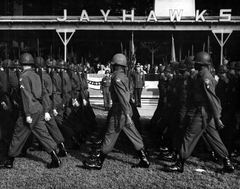
Lieutenant General Louis W. Truman and Troops on Parade During Assumption of Command Ceremony
2014-340
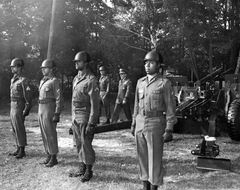
Lieutenant General Louis W. Truman Assumes Command of the United States 7th Army Corps
2014-342
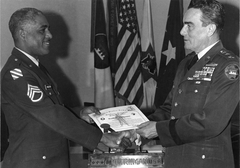
Staff Sergeant Eddie Preston-Chirstain Receives a Certificate of Achievement
2014-447
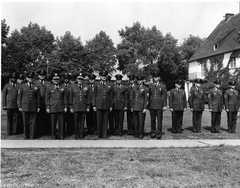
Group Photograph of 35th Artillery Group at Kelley Barracks, Stuttgart, Germany
2014-593
ca.
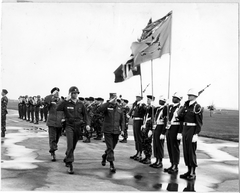
Lieutenant General Louis W. Truman Visits 11th Armored Cavalry Regiment
2014-594
ca.
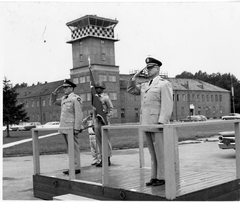
Lieutenant General Truman and Colonel Donald P. Boyer in Ceremony for 11th Armored Cavalry Regiment
2014-638
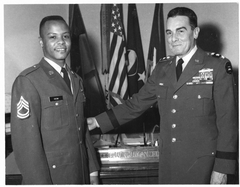
Sergeant First Class Isom is Promoted by Lieutenant General Louis W. Truman
2014-830
ca.
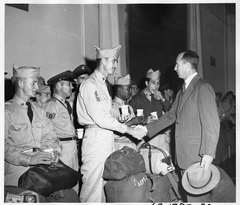
Secretary of the Army Frank Pace Greeting Troops at Fort Mason, California
63-1387-20
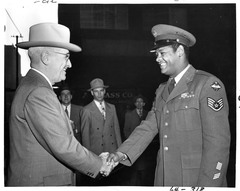
President Harry S. Truman Shakes Hands with African American Air Force Sergeant
64-318
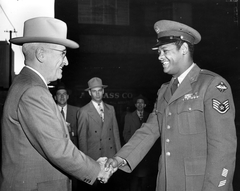
President Harry S. Truman Shakes Hands with African American Air Force Sergeant
65-2494
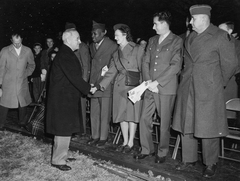
President Truman shakes hands with members of the military at Christmas Tree Lighting ceremony
59-1440-5
